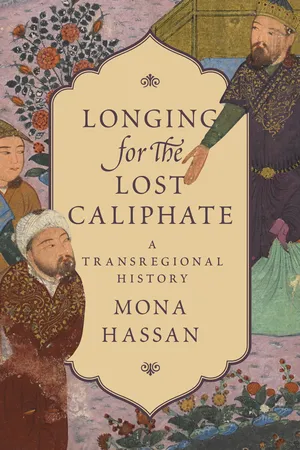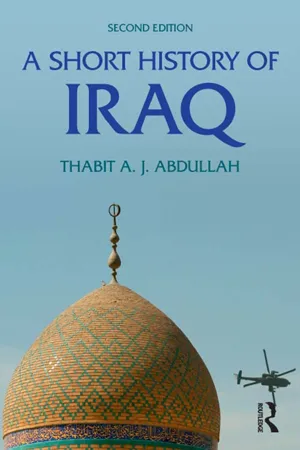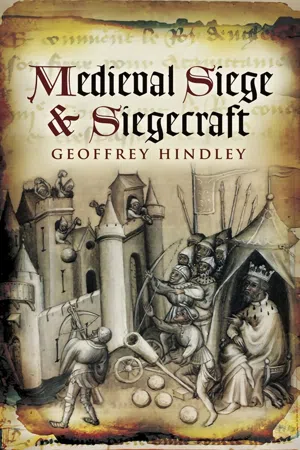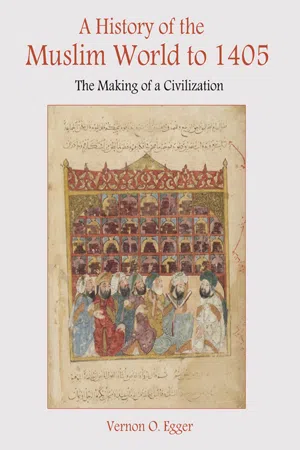History
Siege of Baghdad
The Siege of Baghdad refers to the 1258 invasion and capture of the Abbasid capital by the Mongol Empire, led by Hulagu Khan. The siege resulted in the destruction of the city, including its libraries and scholarly works, marking the end of the Islamic Golden Age. This event had significant repercussions for the Islamic world and the broader history of the Middle East.
Written by Perlego with AI-assistance
Related key terms
Related key terms
1 of 4
Related key terms
1 of 3
5 Key excerpts on "Siege of Baghdad"
- eBook - ePub
Longing for the Lost Caliphate
A Transregional History
- Mona Hassan(Author)
- 2017(Publication Date)
- Princeton University Press(Publisher)
59 al-Kūfī al-Wāʿiẓ bewails this indiscriminate slaughter that befell the people of Baghdad with the words:Oh! what a catastrophe from which no one was saved, so the slave and the king were the same. After [the days of] might of our beloved ones, the hands of the enemies seized them, so they did not spare [anyone] or leave [anything] behind.If only they could have been ransomed from what befell them (nālahum),Oh, how I would have, with my soul (muhjatī) and all that I own.60And in his poetic elegy, Muḥammad b. al-Ḥusayn b. Abī Bakr al-Mawṣilī draws an analogy with the heinous massacre of Karbalā’.61 In total, hundreds of thousands of people lost their lives in Baghdad at the hands of the Mongols, at least eight hundred thousand according to the Muslim sources and over two hundred thousand according to Hülegü himself.62 The anonymous primary source erroneously attributed to Ibn al-Fuwaṭī (642–723/1244–1323) further describes how the dead lay in piles in the streets and markets of the city, where they had met their fate, while rain fell and horses trampled upon their corpses, all together disfiguring and leaving them to putrefy.63 Traumatized by the enormity of these atrocities, Ibn al-Ṭiqtaqā, author of al-Fakhrī, explains, “So much widespread killing, tremendous plunder, and grave mutilation [of the dead] took place that it is difficult to listen to in general terms, so imagine [listening to] the details!”64 - eBook - ePub
Muslim Fortresses in the Levant
Between Crusaders and Mongols
- Kate Raphael(Author)
- 2010(Publication Date)
- Routledge(Publisher)
h was taken only eighteen years later during the reign of Abagha.When a siege camp was eventually organized both sides employed mainly siege machines, and teams were worked night and day. In the Siege of Baghdad an iron ram was used, but this was a rather rare instance. One of the most informative narratives of the Siege of Baghdad is given by , who in one short sentence describes everything that flew through the sky between the two camps: catapult stones, arrows, spears and javelins.76 It seems more than likely that the mounted archers, who were the most dominant force in the Mongol army, dismounted and fired from the ground. This would have increased the number of fighters considerably and provided both a stronger attack and better fire cover for the teams operating the siege machines. On a few occasions the Mongols tried to surround and seal off the city or the fort in order to prevent the population from escaping and food and supplies from entering.The best example of construction work carried out by the Mongols was probably that used at the Siege of Baghdad. After a few weeks of siege the Mongols decided on a change of tactics. This entailed a great investment of time and work, since it included the building of towers that rose above the city walls; once they were completed siege machines were mounted on them, thus gaining the advantage of height. The towers were built of mud bricks, collected from the local town industry, which was positioned outside the city walls. In addition, the water tunnels leading into the city were blocked so that no one could escape.77 Another example of this tactic of surrounding a besieged city can be seen in the siege of Aleppo in December 657/1259. At the outset of the siege, a large earthen rampart known as a chappar was built around the city. While it was being built teams of sappers tried to undermine the foundations of the city wall.78 - eBook - ePub
- Thabit Abdullah(Author)
- 2014(Publication Date)
- Routledge(Publisher)
The Arab conquest of Iraq in 636 introduced new foundations for social harmony through the Arabic language and the Islamic religion which were gradually adopted by the majority of the inhabitants. While old religious and linguistic communities persisted, and new divisions such as the Sunni–Shi‘i schism developed, a degree of harmony under the notion of autonomous communities was established. By the late Umayyad period, the threat of a destructive social conflict had emerged with the problem of tribal competition and the discrimination against the Mawali. In 750, the Abbasid revolution introduced a new vision for social harmony founded on a powerful absolutist central government in Iraq, the equality of all Muslims and a greater commitment to internal development. The new cosmopolitan cities of Iraq, especially Baghdad, became the centres of wealth and the phenomenal flowering of culture. This balance began to unravel by the tenth century, when regional separation, class conflict, the introduction of new peoples from Central Asia and overall economic decline gave way to rising sectarian violence. During the Buwayhid and Seljuk periods, some attempts were made to address these problems, but these dynasties failed to produce new ideas to set the country on a different course and, as a result, central authority gradually grew weaker. The country’s internal weakness left it vulnerable to repeated invasions, which would destroy much of the wealth and deepen communal divisions.Notes and references1 There is some disagreement over the date of this battle, with some historians arguing that it took place in 637 and others in 638.2 During the early Islamic period a number of pious men, known as Qur’anic reciters, memorized large portions of the Qur’an (God’s revelations to the Prophet Muhammad) and were valued as authorities on Islamic belief and practice.3 Quoted in Lewis, Bernard (ed.), Islam: From the Prophet Muhammad to the Capture of Constantinople, New York, 1974, vol. 1, pp. 23–4.4 The name is likely of Persian origin, meaning “The Gift of God”.5 Princeton Online Arabic Poetry, http://www.princeton.edu/~arabic/poetry.6 Quoted in Lewis, Bernard (ed.), Islam: From the Prophet Muhammad to the Capture of Constantinople, New York, 1974, vol. 2, p. 69.7 The Turkish title of “Bey” is roughly equivalent to the Arabic Shaykh, or the Kurdish Agha, all meaning a tribal chief.8 Quoted in Cooperson, Michael, “Baghdad in Rhetoric and Narrative”, Muqarnas - eBook - ePub
- Geoffrey Hindley(Author)
- 2009(Publication Date)
- Pen & Sword History(Publisher)
The extended account of this catastrophe is recorded by a native of Parma, so there may be exaggerations. A few days later, having regrouped his scattered forces, Frederick returned, perhaps to renew the siege. But following a council of war he abandoned the project. The people of Parma had delivered a severe setback to his policy. In far-away England, the monastic historian Matthew Paris heard that the emperor ‘groaned openly as if deeply wounded’.Decisive moments
The chroniclers of the medieval period record many grand sieges, though few as elaborate as the siege described above, in which the prestige of the participants was as important as any military objective in prospect. Time and again an immense army was concentrated to besiege some fortress or walled city even though, as the twentieth-century military analyst Alfred Burne observed, ‘only a limited number of troops could play an effective part in the siege of a town’. For him, such overkill, as we might term it, breached the principle of ‘economy of force’ – a principle that evidently played little part in the plans of the emperor Frederick before Parma.It was his mastery of siegecraft that enabled that more pragmatic monarch, Henry II Plantagenet, King of England and lord of large parts of France, to remain master of his vast domains. In 1161, for example, he took the stronghold of Castillon in Gascony in a matter of days and thoroughly intimidated the local lords so that they dared not take the field against him.A master of siegecraft had to be able to tell, merely by riding round outside the walls of a hostile fortress, whether he could capture it, and, if so, whether the expense of the siege would be worthwhile. In the normal run of things several hostile castles would bar his campaign, and he could attack only one at a time. The defender, by contrast, had to be able to judge to a nicety how long the castle he commanded could hold out against any form of attack, so as to arrange his surrender on terms after the longest possible delay.The Battle of Hastings or Saladin’s victory at Hattin (1187) were, beyond question, key events which (not to labour the metaphor) unlocked developments that can be said to have redirected the course of history in those regions. But there is equally little doubt that the crusaders’ capture of the city of Antioch was as decisive in securing victory in their campaign for Jerusalem as even their brilliant set-piece victory against the odds at Dorylaeum the year before when, in July 1097, they crushed the Turkish army bent on their destruction; while the French capture of Château Gaillard (1204) was epoch-making in a way that even Agincourt could not match. And, in any case, both Hastings and Hattin, being engagements determined by the defence and capture of a hilltop, though both completed within the day and though fought in open terrain, displayed the characteristic feature of the siege, the defence of a strong point. And even at Dorylaeum the action was more in the nature of a siege defence than a battle of manoeuvre: the crusading army, stranded in open desert terrain rather than defending a strong prepared position, it is true, survived only by holding out over a daylong remorseless attack from the Turkish army, rather than by counter-attack. Indeed, it seems that the army’s commanders, having been alerted to the enemy’s presence in the vicinity by their vanguard scouting on ahead, had deliberately taken up something approaching a siege position by pitching camp on a site protected on one flank by marshy ground. - eBook - ePub
A History of the Muslim World to 1405
The Making of a Civilization
- Vernon Egger(Author)
- 2016(Publication Date)
- Routledge(Publisher)
A Civilization Under Siege, 950–1260
By 950, Muslims were justified in feeling a sense of satisfaction in the accomplishments of the past. The agreement upon a methodology for jurisprudence had produced a comprehensive set of rules and laws that Sunnis accepted without question; after a bumpy start, the mystical life was becoming attractive to more and more Muslims; science and philosophy were being selectively incorporated into the Islamic theological framework; and a far-flung commercial network was increasing wealth and stimulating creative solutions to everyday problems. The result was the emergence of a civilization that could compare favorably with any that had existed in history.Despite these achievements, many thoughtful Muslims shared a sense of foreboding about the future of the Dar al-Islam. In 950, three caliphs claimed exclusive legitimacy as leader of the Muslim world, and they were prepared to act upon those claims. The competing claims of authority were exacerbated by differences in religious creeds: The caliph in Cordoba was a Sunni; the one in Mahdiya was a Fatimid Shi‘ite; and in Baghdad, the Sunni caliph was powerless, whereas the Buyid sultan—who exercised the real power in the Abbasid caliphate—supported Twelver Shi‘ism. The sense of lost unity, both spiritual and political, has haunted Muslims ever since, and has been a major factor in the rise of reform movements for more than a millennium.As it turned out, the next three centuries would confirm both the highest hopes and the worst fears of the mid-tenth century. The period from 950 to 1260 witnessed major cultural achievements—many historians judge its cultural productivity to have been one of the most spectacular in world history—but it is dominated by shocking violence and disorder. The first three centuries of Muslim history experienced violence, as we have seen, but it was episodic and most of it occurred between armies. In the second period, by contrast, we witness numerous examples of factional conflict among the inhabitants of the same city, persecution of subjects by their rulers, and “total war” tactics by invading armies, in which farmers and city dwellers alike suffered from ruined property or death, simply for being in the way.
Index pages curate the most relevant extracts from our library of academic textbooks. They’ve been created using an in-house natural language model (NLM), each adding context and meaning to key research topics.
Explore more topic indexes
Explore more topic indexes
1 of 6
Explore more topic indexes
1 of 4




